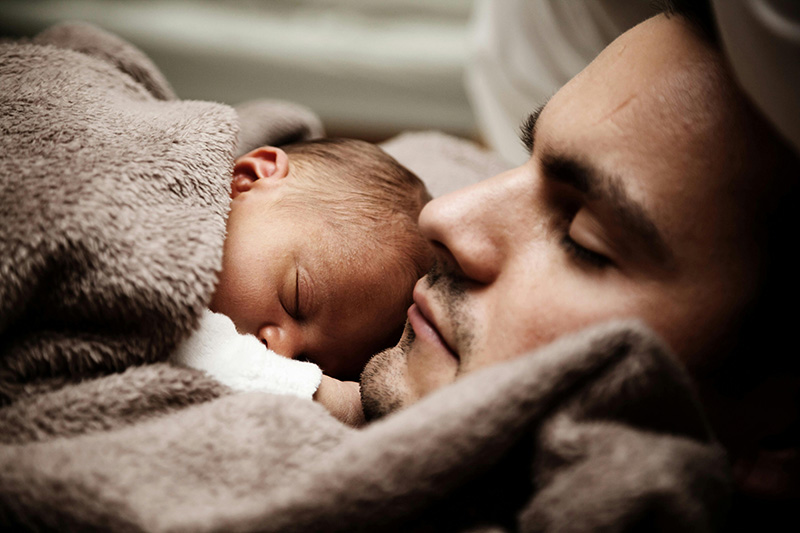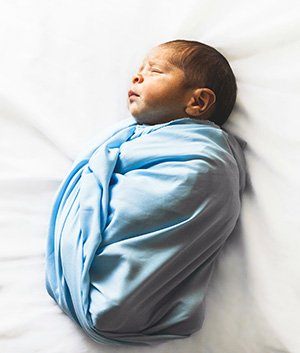How To Help Your Newborn Baby to Sleep

Most newborns sleep anywhere from 14 to 17 hours over a 24-hour period. Their sleep is typically broken into short chunks of about one to three hours, which are spread throughout the day and night. As they grow, these sleep blocks gradually become longer, lasting about four or five hours each. Remember that every baby is unique, so individual sleep patterns may vary. Some newborns sleep for almost all the day and only surface for a feed before slipping back into sleep. You will quickly learn what is best for your child but these tips may help you through the early days.
Safe Sleeping
Research published in 2003 showed that several factors were associated with Sudden Infant Death Syndrome (SIDS):
- Sleep newborns on their back. When children sleep on their front, there is an odds ratio of 2.4 that they will have SIDS. An odds ratio of 2 would mean that there is a 100% increase risk of SIDS. Sleeping on their back would therefore be safer.
- Sleep on a relatively firm surface. Sleeping on a soft surface was associated with an odds ratio of 5.1, presumably because the sheets would envelop the child and prevent breathing.
- Avoid using a pillow. Sleeping with a pillow led to an odds ratio increase risk in SIDS by 2.5.
- Avoid anything covering the head or face. This also increased the risk with an odds ratio of 2.5.
- Avoid sleeping in the same bed. Bed sharing overall increased the odds ratio by 2.7 (bed sharing with a parent(s) alone odds ratio = 1.9 and bed sharing in other combinations gave an odds ratio of 5.1). This is different from sleeping in the same room as your baby which seems to be safe. Experts are assuming therefore that a parent rolls over and smothers a baby during sleep leading to SIDS. If this cannot happen in your bedroom environment, then the risk is back to normal.
- Using a pacifier seemed to reduce the risk of SIDS. With an odds ratio of 0.3, this would indicate that there is less of a risk of SIDS if you use a pacifier (an odds ratio of 1 would mean there is no increase or decrease in risk). Using a pacifier long-term, however, may interfere with the growth of teeth and lead to some dependence.
- Breastfeeding helps reduce risk of SIDS. Breastfeeding reduced the odds ratio down to 0.2 indicating that it significantly helped.
Go To Bed When Drowsy
Holding on to a baby, waiting for them to sleep, and then trying to sneak them into the cot without waking them up does work, but it does not help your baby learn how to soothe themselves to sleep. When you see that your baby is drowsy, moving them into the bedroom and helping them to fall asleep in their bed will help them learn that this is bedtime. When they wake up, instead of them crying because they want to be in your arms to sleep again, they will slowly learn to soothe themselves to sleep again as they aren’t frightened by their environment.
It is also really important that you can pick up the signs of your child being drowsy. It is really hard to soothe a child who is ‘overtired’ and is so irritated that they cannot drop off to sleep. Picking up the early signs of drowsiness in your baby will make things much easier for you later on, especially when trying to avoid an overtired child.
Swaddling

Swaddling is the practice of wrapping up a baby in cloth. This seems to help soothe them and we believe it helps them remember what it was like in the womb. Research indicates that swaddling, when combined with sound and movement, effectively soothes crying babies. Additionally, swaddling can promote deeper and longer sleep. Another study observed that premature babies who were swaddled exhibited greater calmness, improved neuromuscular development, better muscle tone, and reduced pain and discomfort.
There is a risk of swaddling causing hip problems (hip dysplasia) so make sure your baby is able to move their legs around whilst swaddled. Also, make sure that the swaddling is not around the neck or head, keep the cloth from going above the shoulders.
Below are some other tips to swaddle your baby safely:
Temperature and Clothing:
- Be mindful of your baby’s temperature and surroundings to prevent overheating.
- Avoid placing any other blankets over them.
- Regularly check their temperature and dress them appropriately for the weather.
- Avoid swaddling if your baby is unwell or has a fever.
Swaddling Technique:
- Use thin materials like a small cotton sheet or muslin square for swaddling.
- Ensure the swaddle material is secure and won’t come loose. Remember the advice about SIDS and cloth covering the face or head.
Swaddle Safety:
- Check swaddle products for safety standards, proper fit, and any damage.
- Follow manufacturer guidelines on age or weight ratings.
- If anyone else is looking after your baby whilst you are away, do make sure they understand how to swaddle safely and protect your baby.
Bedroom Environment

Consider the following:
- A dimly lit, peaceful bedroom is ideal for newborn children.
- Remember the temperature should be about 18 degrees Celsius (check the temperature at the level of your baby’s cot as heat rises).
- A quiet room is important (no TV in the background etc), but also using sound to your advantage can be useful. White noise generators, gentle lullaby music, water sounds have helped children soothe themselves to sleep. You can also gently sing or repeatedly hush a child to sleep, which works in the same way as music and noise generators. Be careful not to over-use these techniques as they create associations with sleep particularly when they are older. It may be hard for children to sleep later without these sounds, making it hard when going on holiday or on sleepovers.
- Sleeping on a cot that swings a little can be a simple way for newborns to drop off to sleep, but again avoid over using this technique. Try to move away from relying on movement to get to sleep as again it will be hard when a deep association is created with this technique. Fine in the initial stages but consider phasing it out later.


